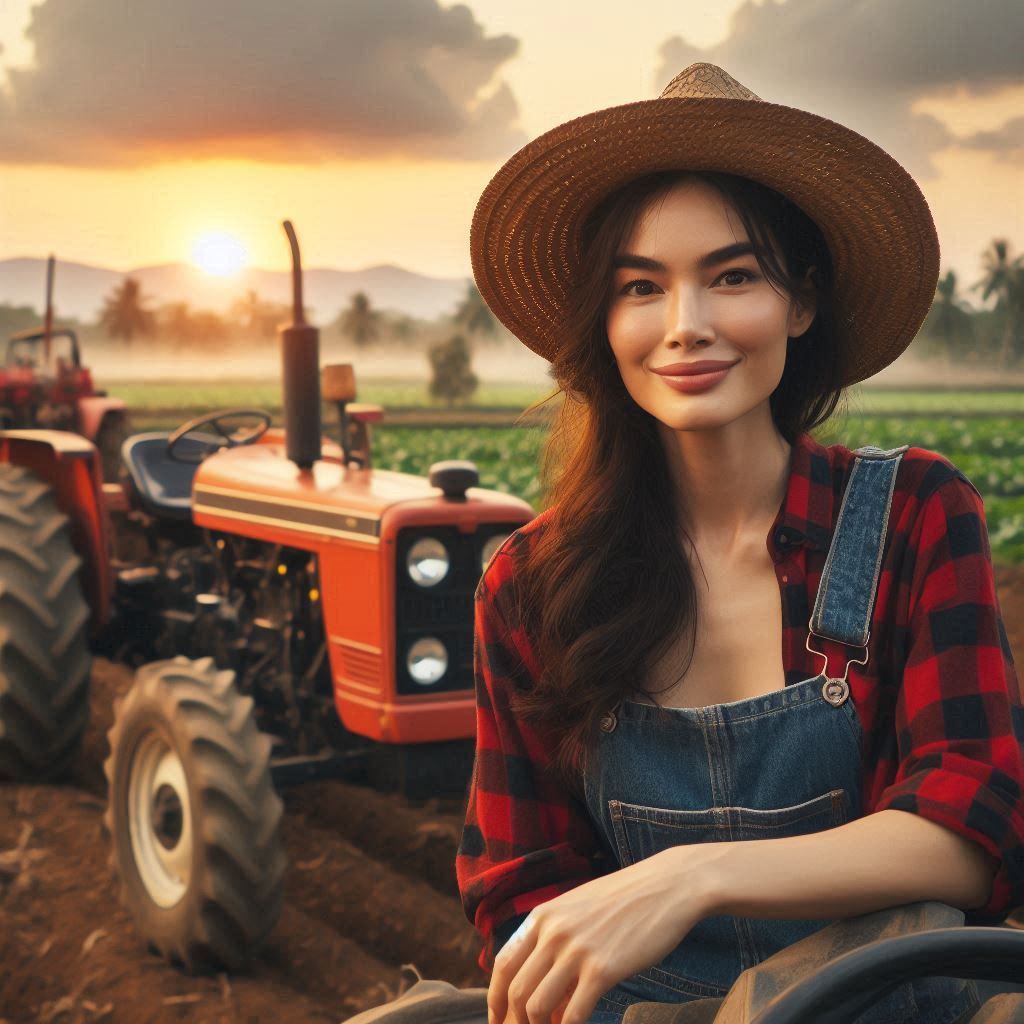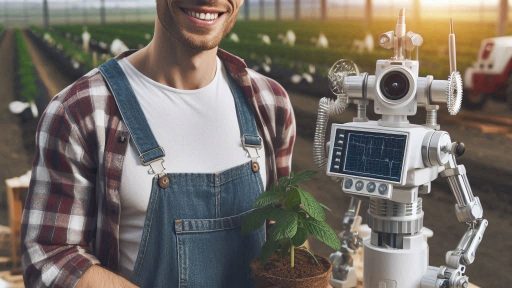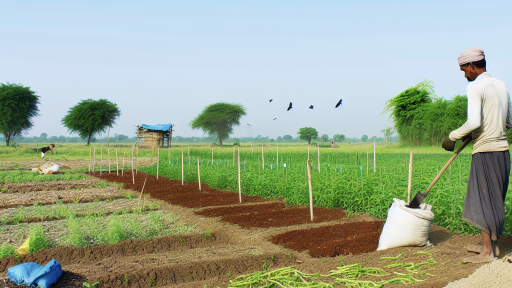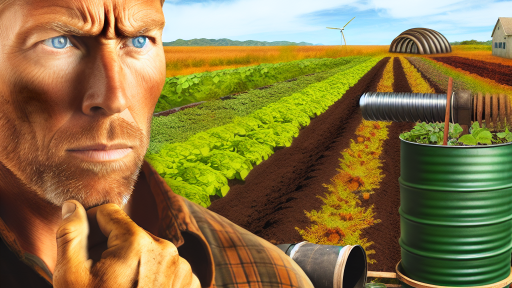Introduction
Traditional farming methods relied on manual labor and simple tools.
These techniques served farmers for generations.
However, global challenges like climate change and population growth demand more efficient solutions.
Modern farming techniques offer answers to these pressing issues.
Farmers now face the need to produce more with fewer resources.
Water scarcity, soil degradation, and changing weather patterns make traditional methods less effective.
Modern farming techniques address these challenges through innovation and technology.
Key Differences:
- Traditional farming focuses on manual labor and local knowledge.
- Modern farming relies on technology, precision, and data-driven decisions.
Why Modern Farming Matters:
- Increases crop yield and efficiency.
- Reduces resource consumption and waste.
- Adapts to environmental changes swiftly.
This post aims to guide you through the essential modern farming techniques.
You’ll learn how these methods can transform your farming practices.
By embracing these techniques, you can meet today’s agricultural demands.
Whether you’re a seasoned farmer or new to the field, this guide will equip you with the knowledge needed to succeed in modern farming.
Precision Agriculture
Precision agriculture is a farming technique that uses advanced technology to manage fields with accuracy and efficiency.
It allows farmers to optimize their inputs and maximize their yields.
Key Benefits of Precision Agriculture
- Enhanced Efficiency: Precision agriculture reduces waste by applying the right amount of resources where needed.
- Increased Yields: Farmers can produce more crops by managing their fields more precisely.
- Cost Reduction: By optimizing input use, farmers reduce costs on fertilizers, water, and pesticides.
- Environmental Sustainability: Precision agriculture minimizes environmental impact by reducing overuse of chemicals and conserving water.
Tools and Technologies Involved
- GPS (Global Positioning System): GPS technology guides machinery with pinpoint accuracy, ensuring precise application of inputs.
- Drones: Drones provide aerial views of fields, helping farmers monitor crop health and identify issues early.
- Sensors: Soil and crop sensors measure various parameters, allowing farmers to adjust their practices in real-time.
- Yield Mapping: This technology tracks the amount of produce harvested, identifying high and low-yield areas.
Applications of Precision Agriculture
- Soil Sampling: Farmers use GPS-guided soil sampling to collect accurate data on soil conditions across different field zones.
- Crop Monitoring: Drones and sensors help farmers monitor crop growth, detect diseases, and identify nutrient deficiencies.
- Yield Mapping: Yield mapping software collects data during harvesting, revealing patterns and trends in crop production.
- Variable Rate Technology (VRT): VRT adjusts the application rates of seeds, fertilizers, and pesticides based on specific field conditions.
Real-Life Examples and Case Studies
- Smith Family Farms: Smith Family Farms in Iowa adopted precision agriculture to improve corn yields.
They used GPS-guided equipment for planting and soil sampling.
Drones monitored crop health, and yield mapping identified areas needing more attention.
As a result, they increased their corn production by 15% in one season. - Green Valley Vineyards: Green Valley Vineyards in California used precision agriculture to optimize their irrigation system.
They installed soil moisture sensors and employed drones for vineyard monitoring.
The vineyard reduced water usage by 20% and improved grape quality. - Miller Dairy Farm: Miller Dairy Farm in Wisconsin utilized precision agriculture to manage their forage crops.
They used VRT to apply fertilizers and tracked yields with mapping software.
This approach boosted their feed quality and reduced input costs.
Precision agriculture is transforming modern farming by leveraging advanced tools and technologies.
Farmers can enhance efficiency, increase yields, and promote sustainability.
By adopting these techniques, they are better equipped to meet the challenges of modern agriculture.
As demonstrated in the case studies, precision agriculture offers tangible benefits that can lead to significant improvements in farming operations.
Hydroponics and Aquaponics
Hydroponics and aquaponics are innovative farming techniques that have gained popularity in recent years as a sustainable and efficient way to grow crops.
These systems offer numerous advantages over traditional soil-based farming, making them an attractive option for modern farmers looking to maximize their yields while minimizing their environmental impact.
Hydroponics and Aquaponics Systems
Hydroponics is a method of growing plants without soil, using nutrient-rich water solutions to deliver essential minerals directly to the plant roots.
Aquaponics combines hydroponics with aquaculture, where fish waste provides nutrients for plants, and plants in turn help purify the water for the fish.
Advantages Over Traditional Soil-Based Farming
- Efficient water use: Hydroponic and aquaponic systems use significantly less water than traditional farming methods, making them ideal for areas with water scarcity.
- Faster growth rates: Plants grown in hydroponic and aquaponic systems typically grow faster and produce higher yields than those grown in soil.
- Year-round cultivation: These systems can be set up indoors or in controlled environments, allowing for year-round cultivation regardless of weather conditions.
- Space-saving: Hydroponic and aquaponic systems can be scaled to fit various spaces, making them suitable for urban areas or small farms with limited land.
- Reduced pest and disease pressure: By eliminating soil, these systems reduce the risk of pests and diseases that often affect traditional crops.
Basic Components and Setup
- Reservoir: Holds nutrient-rich water in hydroponic systems or fish in aquaponic systems.
- Grow bed or tray: Where plants are grown with their roots submerged in the nutrient solution.
- Pump: Circulates water in hydroponic systems or moves fish waste in aquaponic systems.
- Grow lights: Provide artificial light for plants in indoor hydroponic setups.
- Fish tank: Houses fish in aquaponic systems, where their waste fertilizes the plants.
Case Studies of Successful Implementations
- Growing Underground: Located in the heart of London, Growing Underground is an urban hydroponic farm that produces a variety of herbs and microgreens using sustainable farming techniques.
- Ouroboros Farms: Based in California, Ouroboros Farms is a successful aquaponic farm that grows leafy greens, herbs, and fish in a closed-loop system, showcasing the benefits of aquaponics for sustainable food production.
- Edenworks: Operating in New York City, Edenworks utilizes aquaponics to grow fresh produce in a controlled environment, demonstrating the potential of aquaponics for urban farming.
In general, hydroponics and aquaponics offer modern farmers a sustainable and efficient alternative to traditional soil-based farming.
With their numerous advantages and successful case studies, these systems have the potential to revolutionize the way we grow food and address the challenges of feeding a growing global population in a resource-efficient manner.
Vertical Farming
Concept and Benefits of Vertical Farming
Vertical farming is a revolutionary agricultural technique that involves growing crops in vertical layers, rather than horizontally on a single level.
This method maximizes space utilization and allows for efficient use of resources such as water and light.
By utilizing vertical space, farmers can produce higher yields in a smaller footprint compared to traditional farming methods.
Additionally, vertical farming creates a controlled environment that minimizes the need for pesticides and reduces the risk of crop diseases.
Types of Vertical Farming Systems
There are several types of vertical farming systems, each with its own unique advantages and applications.
Two popular systems include:
- Aeroponics: This system involves growing plants in an air or mist environment without the use of soil.
Nutrient-rich water is sprayed onto the plant roots, providing essential nutrients for growth. - Stacked Hydroponics: In this system, plants are grown in trays or towers stacked on top of each other.
Nutrient solutions circulate through the trays, delivering nutrients directly to the plant roots.
Urban Farming: Utilizing Indoor Spaces and Rooftops
Vertical farming is particularly well-suited for urban environments where land is scarce and expensive.
By utilizing indoor spaces such as warehouses and rooftops, urban farmers can grow fresh produce close to consumers, reducing the carbon footprint associated with transportation.
Urban vertical farms also provide opportunities for community engagement and education about sustainable agriculture practices.
Potential Challenges and Solutions
While vertical farming offers numerous benefits, it also comes with its own set of challenges.
Some common issues include high upfront costs, energy consumption, and technical expertise required to operate vertical farming systems.
However, innovative solutions are being developed to address these challenges, such as implementing renewable energy sources to reduce energy costs and providing training programs for farmers to improve their skills.
Read: Digital Age Farming: Millennials on the Field
Transform Your Agribusiness
Unlock your farm's potential with expert advice tailored to your needs. Get actionable steps that drive real results.
Get StartedBiotechnology in Farming
Biotechnology plays a critical role in modern farming.
It introduces innovative solutions that transform agriculture and address various challenges.
Role of Genetically Modified Organisms (GMOs)
GMOs have revolutionized farming by enhancing crop traits.
Scientists modify these organisms to improve yield and resistance to pests.
Farmers use GMOs to produce crops that grow faster and require fewer resources.
These modifications help farmers meet the increasing global food demand efficiently.
Additionally, GMOs enable the cultivation of crops in previously inhospitable environments.
This adaptability is crucial as arable land becomes scarcer.
Moreover, GMOs reduce the need for chemical pesticides, lowering farming costs and environmental impact.
This genetic technology is a cornerstone of modern agriculture.
Advancements in Crop Protection
Biotechnology has also advanced crop protection.
Scientists have developed pest-resistant and drought-tolerant crops using genetic engineering.
Pest-resistant crops reduce the need for harmful pesticides.
This shift protects the environment and promotes healthier ecosystems.
Drought-tolerant crops ensure stable yields despite unpredictable weather patterns.
These crops are vital for maintaining food production in regions facing water scarcity.
Farmers can now produce consistent harvests, even in challenging conditions.
Biotechnology thus empowers farmers to protect their crops and secure their livelihoods.
Ethical and Environmental Considerations
Despite its benefits, biotechnology in farming raises ethical and environmental concerns.
Critics argue that GMOs might pose health risks and harm biodiversity.
The long-term effects of consuming GMOs remain a topic of debate.
Additionally, the widespread use of genetically modified crops may reduce genetic diversity.
This reduction could make crops more vulnerable to diseases.
Some also question the corporate control over GMO seeds, fearing it may limit farmers’ autonomy.
Environmentalists worry about the unintended consequences of GMO cultivation on ecosystems.
However, rigorous testing and regulation help mitigate these risks.
The ongoing dialogue between scientists, policymakers, and the public is essential to address these concerns.
Contributions to Food Security and Sustainability
Biotechnology contributes significantly to food security.
GMOs and advanced crop protection methods increase food production and resilience.
These innovations help meet the growing global population’s needs.
By reducing crop losses from pests and extreme weather, biotechnology ensures a stable food supply.
Furthermore, biotechnology supports sustainable farming practices.
GMOs can reduce the reliance on chemical inputs, lowering environmental pollution.
Drought-tolerant crops conserve water, a precious resource in agriculture.
These advancements make farming more sustainable and efficient.
Biotechnology thus plays a vital role in securing the future of food production.
Basically, biotechnology is a powerful tool in modern farming.
It enhances crop productivity, protects against environmental threats, and supports sustainability.
However, it also raises important ethical and environmental questions.
Balancing these benefits and concerns is crucial for the future of agriculture.
Read: Tech for Sustainable Farming: Our Path

Robotics and Automation
Advantages of Robotics and Automation in Modern Farming
- Increased efficiency in planting and harvesting processes.
- Precise application of resources such as water, fertilizers, and pesticides.
- Reduction in labor costs as robots can perform repetitive tasks.
- Improved crop quality and yield due to consistent care and monitoring.
- Enhanced safety for workers by taking over hazardous tasks.
Challenges and Limitations of Farm Robotics
- High initial investment costs for purchasing and maintaining robots.
- Complexity in integrating various robotic systems on the farm.
- Dependency on technology leading to potential system failures.
- Lack of flexibility in adapting to changing environmental conditions.
- Concerns about job displacement and impact on rural communities.
Future Trends and Innovations in Farm Robotics
- Continued development of autonomous vehicles for field operations.
- Integration of artificial intelligence for decision-making processes.
- Advancements in sensor technologies for real-time monitoring of crops.
- Expansion of drone applications for crop surveillance and spraying.
- Collaborative robots working alongside human workers for increased productivity.
Generally, robotics and automation play a crucial role in modern farming, offering numerous benefits in terms of efficiency, precision, and safety.
While there are challenges to overcome, the future holds promising developments that will further revolutionize the agriculture industry.
Read: High-Tech Farming on Small Land: Insights
Sustainable Farming Practices
Farming practices that are sustainable are essential in modern agriculture to ensure the longevity of the environment, soil, and resources.
These practices focus on minimizing negative impacts on the ecosystem while maximizing productivity and efficiency.
Importance of sustainability in modern farming
Importance of sustainability in modern farming: Sustainability in farming is crucial for maintaining healthy ecosystems, preserving natural resources, and addressing the challenges of climate change and food security.
By adopting sustainable practices, farmers can reduce their environmental footprint and enhance the resilience of their operations.
Key practices: Crop rotation, cover cropping, reduced tillage
- Crop rotation: Rotating crops helps to break pest cycles, improve soil fertility, and reduce the need for chemical inputs.
It also enhances biodiversity and promotes healthier soil ecosystems. - Cover cropping: Planting cover crops during fallow periods helps to prevent soil erosion, suppress weeds, and improve soil structure.
Cover crops also add organic matter to the soil and enhance its nutrient content. - Reduced tillage: Minimizing tillage practices can help to preserve soil structure, reduce soil erosion, and promote water infiltration.
Reduced tillage also conserves soil moisture and organic matter, leading to improved soil health.
Benefits for soil health and biodiversity
Sustainable farming practices contribute to improved soil health by maintaining soil structure, fertility, and microbial activity.
These practices also support biodiversity by providing habitat for beneficial insects, birds, and other wildlife.
Integration of renewable energy (solar, wind) on farms
Farmers can further enhance sustainability by integrating renewable energy sources, such as solar panels and wind turbines, into their operations.
These energy sources can help reduce greenhouse gas emissions, lower energy costs, and promote energy independence.
Overall, adopting sustainable farming practices is essential for ensuring the long-term viability of agriculture, protecting the environment, and meeting the growing demand for food in a changing climate.
By implementing these practices, farmers can contribute to a more sustainable and resilient agricultural system.
Read: From Seeds to Satellites: Farming’s Tech Shift
Smart Irrigation Systems
Necessity of efficient water management
Efficient water management is crucial in modern farming to optimize crop yield and conserve resources.
Smart irrigation systems play a pivotal role in achieving these goals by delivering water directly to plant roots.
Types of smart irrigation systems: Drip irrigation, sprinkler systems
Drip irrigation is a popular technique where water droplets are released slowly, minimizing evaporation and water wastage.
Sprinkler systems, on the other hand, distribute water through a network of pipes with adjustable nozzles for targeted watering.
Role of IoT (Internet of Things) in irrigation management
The Internet of Things (IoT) has revolutionized irrigation management by providing real-time data on soil moisture levels and weather conditions.
IoT-enabled systems can automatically adjust watering schedules based on environmental factors, ensuring optimal plant hydration.
Case studies and examples of water savings
Case studies have shown significant water savings with the implementation of smart irrigation systems on farms worldwide.
For example, a study in California reported a 30% reduction in water usage with the adoption of drip irrigation technology.
In Australia, a vineyard saw a 50% decrease in water consumption after installing a smart sprinkler system.
Showcase Your Farming Business
Publish your professional farming services profile on our blog for a one-time fee of $200 and reach a dedicated audience of farmers and agribusiness owners.
Publish Your ProfileThese examples demonstrate the tangible impact of smart irrigation systems on agricultural sustainability and efficiency.
By harnessing technology and data-driven insights, farmers can enhance crop production while conserving precious water resources.
Investing in smart irrigation systems is not only beneficial for the environment but also for the long-term profitability of farms.
Data Analytics and Farm Management Software
With the advancement of technology, data analytics and farm management software have become invaluable tools for modern farmers.
Importance of data in modern farming
- Allows farmers to make informed decisions.
- Improves crop yield and overall productivity.
- Helps in predicting and managing risks.
Types of data collected: Weather, soil health, crop performance
- Weather data helps in planning planting and harvesting schedules.
- Soil health data guides farmers in applying the right nutrients.
- Crop performance data helps in monitoring growth and identifying issues.
Popular farm management software tools
- FarmLogs
- Farmbrite
- Agrivi
- Cropio
- Farm Matters
Benefits in decision making and operational efficiency
- Real-time data analysis leads to better decision-making.
- Reduces wastage of resources and increases cost-effectiveness.
- Streamlines farm operations and improves overall efficiency.
- Helps in complying with regulatory requirements and certifications.
Conclusion
In this guide, we explored essential modern farming techniques shaping today’s agriculture.
These advancements drive efficiency and sustainability.
- Precision Farming: Farmers use data to optimize crop yields and resource management.
This technology reduces waste and boosts productivity. - Hydroponics and Aquaponics: These soilless farming methods offer sustainable solutions for growing crops in urban areas and harsh climates.
- Drones and Automation: Drones monitor crops, while automation handles repetitive tasks.
These tools save time and increase accuracy. - Biotechnology: Genetic engineering improves crop resistance and yield, helping farmers meet growing food demands.
Looking ahead, farming will continue evolving with technology.
Innovations like AI and robotics will further transform agriculture.
Farmers must adopt these techniques to ensure sustainability and food security.
Embracing modern farming techniques is crucial for the planet’s future.
It ensures we meet the needs of a growing population while preserving resources.
Staying informed about new advancements in agriculture is vital.
Commit to continuous learning and innovation in farming.
By doing so, you contribute to a sustainable, food-secure future.
The path to modern farming success is paved with knowledge and adaptation.




